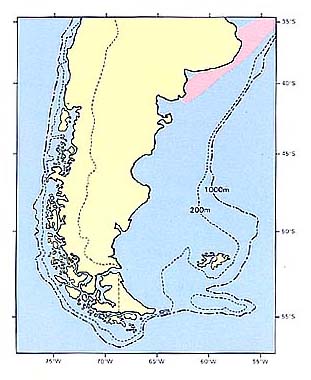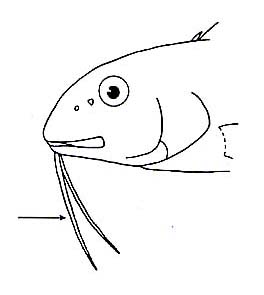ヒメジ科
- HOME
- デジタル図鑑
- パタゴニア海域の重要水族
- 硬骨魚綱 スズキ目
- ヒメジ科
ヒメジ科(Mullidae)

86 アカメヒメジ(Akame-himeji)
Mullus argentinae Hubbs et Marini, 1933
Barbo, Barbillo (Arg.); Barbo americano (Urg.)
特 徴:
第1背鰭7棘,第2背鰭1棘,8軟条,臀鰭2棘,6軟条,胸鰭15〜17軟条,腹鰭1棘,5軟条,側線鱗数34,鰓耙数5〜7+11〜14=17〜21。体長に対する体高の割合は27.9〜30.0%,頭長は28.2〜30.0%,眼径は6.7〜7.9%,両眼間隔は7.3〜8.6%,吻長は11.4〜12.1%,上顎長は10.0〜10.9%,尾柄高は10.7〜11.9%,胸鰭長は23.1〜25.0%,腹鰭長は21.9〜23.6%,下顎髭長は19.0〜21.4%,背鰭前長は37.0〜38.7%。体はやや細長く,側扁する。吻から眼の上縁にかけての頭部外郭は突出する。眼は大きい。吻は円鈍,両眼間隔域は突出し,平坦でない。下顎は上顎より短い。口はやや大きく水平で,前上顎骨の後端は成魚では少なくとも眼の前縁下に達する。下顎に円錐状の1列の歯が並ぶ。上顎に歯はない。口蓋骨に歯がある。主鰓蓋骨後縁に棘がなく,前鰓蓋骨後縁にも鋸歯はない。尾鰭は深く二叉する。下顎先端に2本の長いひげ(触鬚)があり,その先端は前鰓蓋骨の後縁下を超える。体の背方は赤色で,腹方は赤桃色。第1背鰭先端に大きな黒斑があるか,あるいは漆黒色の縞がある。第2背鰭に3条の縞がある。尾鰭中央鰭条の先端は黒色で,上下両葉に不明瞭な縞紋様がある。胸鰭,腹鰭とも赤い。臀鰭鰭条は淡い桃色であり鰭膜は半透明,その基部は乳白色。ほほから前鰓蓋部にかけては銀白色。
分 布:
ウルガイからアルゼンチン北部の沿岸域,水深20〜60mに分布する。
備 考:
本種は北米東岸からカリブ海にかけて分布するM. auratusとは第1背鰭条数(8本)および第1背鰭の縞によって区別される(Hubbs and Marini, 1935)。
(稲田伊史)
Material examined:
4 from Argentina (97.2-155.8 mm SL), FSFL EL 774; EM 229, 230, 508.
Description:
D Ⅶ, Ⅰ, 8; A Ⅱ, 6; P1 15-17; P2 Ⅰ, 5; LLS 34; GR 5-7+11-14=17-21. HL 28.2-30.0% of SL; ED 6.7-7.9; BD 27.9-30.0; SN 11.4-12.1; IO 7.3-8.6; JD 10.0-10.9; CP 10.7-11.9; P1L 23.1-25.0; P2L 21.9-23.6; Barbel L 19.0-21.4.
Body oblong, deep, slightly compressed. Snout blunt, steep, high; dorsal profile of head gradually arched downward before dorsal fin becoming abruptly declivitous on snout. Eye large. Interorbital space wide, convex. Mouth large and horizontal; lower jaw more inferior than upper; posterior end of upper jaw reaching to below anterior eye margin, at least in adults. Round-tipped teeth in one series on lower jaw, with a few smaller teeth forming an incipient second row. No teeth on upper jaw. Palatine with a pair of large patches of submolar teeth. No spine on opercular margin and no serration on preopercular margin. Caudal fin deeply forked. Two long barbels on chin extending posterior to posterior margin of preopercle at their tips. Upper part of body reddish, lower part pinkish. A large blotch or band of jet black near tip of first dorsal fin. Three bands on second dorsal fin. Posterior median rays of caudal fin blackish, both lobes with indistinct bands. Pectoral and pelvic fins reddish. Anal fin rays pale pinkish, its membrane translucent, and its base milky white. Cheek and preopercle silvery white.
Distribution:
Coasts from Uruguay to northern part of Argentina in depths of 20-60 m.
Remarks:
This species is distinguished from M. auratus, Which is known from the east coast of North America and the Carribean Sea, by the number of 1st dorsal fin rays and the color of fins (Hubbs and Marini, 1935).
(Tadashi INADA)

Distribution of Mullus argentinae in Patagonia.

Head in lateral view. Barbel arrowed.
- 1